Subramaniapuram
Subramaniapuram : Movie Review
5 stars out of 5 (Masterpiece)
Tamil (English subtitles available), 2008
Director & Writer : S.Sasikumar
Cinematographer : S.R. Kathiir
Composer : James Vasanthan
The setting is a river bed from where the water has receded, and the light is fading. A man sits on these sands, soaked in anger and throbbing revenge. The brown bag he earlier held in his hands is of the type that many South Indians will recognize - it is made of jute (a fine sturdy alternative to the plague of polythene), is inscribed with Tamil lettering and is normally used for grocery and shopping. But this bag is stained deep with blood and its contents are best left to the reaches of grisly imagination. Another man draws up and we know by now that they are friends. And we will also soon know what Subramaniapuram fully stands for.... An uneasy current of foreboding builds up, terror commingles with realization and scythes and shouts populate the air. And the shot closes not by an ordinary switch of frame but by continuously stretching, without cuts, as it smoothly traces the path of the man as he descends by ascending onto a dirt path that winds its plant-rimmed undulating way, on and on smoothly leading, to a tar road where a lumbering classic of India - The Ambassador Car (which beat all other competitors in a BBC Top Gear race) is waiting. This virtuoso sequence compendiates all that is impressive about Subramaniapuram - superior stylish camerawork, inspired mood-enhancing music, and story-telling gravitas. Director, Writer and Producer M.Sasikumar helms this "rise of the thug" enterprise that became a sleeper hit in the great state of Tamil Nadu and so distinguished itself by its technical elegance and emotional power that it inspired Hindi auteur Anurag Kashyap to create another gangster scorcher "Gangs of Wasseypur I ".
The class of the visuals is evident right from the opening credits and this elevates the entire movie. The camera scans the city at night and the areas seems cleaner than your average Indian town. S.R. Kathir gives all indications of being a born cinematographer, with a knack for light colours, fluid movement and graceful angles. Even when his lens looks at terrible toilets and grungy prison environs, there's a sense of neatness and organization in his frames, enhanced by Rembon B.'s production design. Judicious jump cuts, slowing down when necessary to amplify the scene and amorphous iris shots are all sprinkled in - this is also a well-edited movie.
Sasikumar's subject may be low-lifes, but he accords them the high treatment, and the film's various artists gel so well that the movie consistently vaults above the middle ground. The title is a fictitious name given to Madurai of 1980. Primitive-looking black and white TVs play the famous Hindi film song "Yaadon ki baarath" while a family happily watches this show. 30-feet-tall hoardings of Rajnikanth are erected by crazed hordes of fans who riot and dance inside the movie theater; the whole town gears up for the pageantry of processions as the temple festival is boisterously celebrated and a way-side shop's gramaphone plays a hoary Tamil film romantic number while our man and his lady who's passing by quietly embody the lyrics. We are steadily introduced to the movie's central gang - a group of five youth who studiously work at essaying jobless thugs.
Three of them necessitate mention. We are first introduced to the dubious antics of Sasi - an uncouthly dressed, amusing lout who seems born to play the shady middleman. And then there are the 70s dudes - Paraman (the director himself) and Azhagar (Jai). Both of them are bearded, with copious smooth cephalic hair and they wear patterned full-sleeve shirts - as chic now as they were then, and bell-bottom pants.These two exasperate their lower-middle class families, sit around smoking, drinking and brawling, while spurning formal employment , seemingly not caring about earning money. While both smoulder and brood, Azhagar has the lighter heart of the two while Paraman is perpetually grave and peeved. Their allegiance and care for each other comes through.
(R) Paraman (S.Sasikumar) (L) Azhagar (Jai)
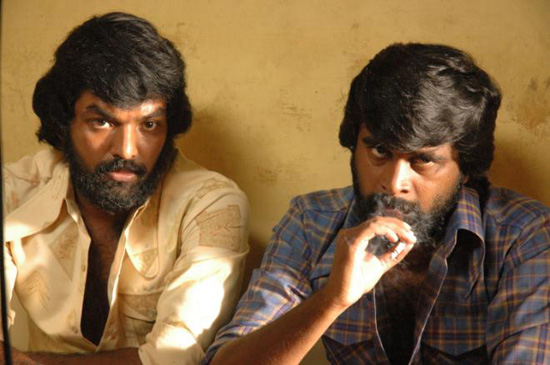
No girl in the history of cinema has shot as many sideward and backward coy glances as Tulasi has at Azhagar. All that coyness has its price, as we shall see much later. Swathi Reddy plays Tulasi - the innocent and sweet daughter of a dark-hearted political household that principally spews the venom in this story. Paraman warns Azhagar that this dalliance has a guarded prognosis but that doesn't prevent the young lovers from painting the town red with medium-distance visual intercourse...there's no shortage of smiling, blushing, and slyly ending up in each other's vicinity. If looks could consummate, then this pair would have had a brood of at least a dozen kids....
The director makes no bones about the fact that his two (anti)heroes are thuggish to the core. They both enjoy the barbaric frenzy of brawls, of beating up people and generally acting like scoundrels.. In a fight outside a cinema theatre, Azhagu beats a man to the ground, and then wantonly throws a metal bucket onto his face while the man screams in agony. Paraman has no qualms about eve-teasing: in a temple festival he pulls the hair of young women passing by - the second girl's wig comes off and Paraman spitefully flings the hairpiece at the embarrassed girl's face. The only redeeming features of these two are that they are loyal and fearless. We don't want them to get killed because we subconsciously build a connection towards them, however bizarre that connection may seem, but otherwise their behaviour is so repulsive that we don't really care if they get brutally beaten up.
Paraman and Azhagar soon get suckered into carrying out hard-core criminal missions, and the knife turns deeper when they are in for a long haul in prison. A saviour looms in the form of a young inmate who promises to bail them out of prison. He offers them both plates of lunch and a camaraderie forms, but quite likely our two men haven't heard of the phrase "There's no free lunch". Their predicament darkens further, and though they bravely and flamboyantly hold their own, they tumble deeper into a criminal vortex where no one else shares their sense of loyalty...
Sasikumar is scathing of the society and land he depicts. Not a single thread which weaves this story comes off showing a decently led human life. We see a culture of Teutonic low-lifes who are conveniently used by the local honchos for political homicide. These street-level bigwigs cultivate the society of thugs and show benevolence towards them so that at the opportune time they will have hitmen ready when wanted. The police are efficient in quelling brawls and beating up the thugs, but they become obedient spaniels the minute a phone call comes from the local leaders - bribes no doubt lubricate this behaviour. A cross-hierarchical genuine romance blooms but it has little chance since the man is an idiot and the girl is a vulnerable member of an influential but malignant family.
The finest musical achievement in the film comes from debut composer James Vasanthan's song - Kangal Irandaal - which catapulted him to fame. It is a marvel of fey tunes and a cousin of such mellifluously melodic 'Tamil-sounding' songs as Harris Jayaraj's 'Sutrum Vizhi'. Vasanthan splendidly deploys flute, cellos, synthesizer blends, percussion and smooth flowing voices for this marquee composition. Note how he takes choice chunks of this song for the background score and tweaks them to fantastic effect in the scene where Tulasi gets off a bus and has her first orgy of furtive glances with Azhagar. In its sly understanding, youthful goofiness of innocent blooming romance and the delighted blushing smiles exchanged, the scene is a masterpiece by itself.
Vasanthan's music, wedded to the visuals in poignant classy fashion, is also notable in "Kaadal Silvayil". In the first few seconds as this song starts I was reflexively reminded of one of those mediocre songs of lamentation so often heard in the filmic patheon of all four South Indian states - of a type which is bereft of talent and spilling over with melodrama such that it is smacks more of stupidity than sadness. But this one soars under the right baton. Shankar Mahadevan uncannily recalls Sukhwinder Singh's zesty singing which imparts flamboyance to folk. Good sound recording and the overall caliber of the instrumentation comes through. Kathir's camera at a mid-way point looks at Azhagar sitting morosely in the prison courtyard and then swings skyward. Expansive wistful waves of cello take off from where the voices' crescendo tails off, and as Tulasi walks past Azhagar's gaze and disappears like an apparition, he runs and follows her in the lanes of a labyrinth. As he chases her through those long narrow passageways, the walls of mortared stone surge towards us and recede fluidly while trumpets introduce a sharper, bracing rhythm to pierce through his surreal search and underline his hard bleak reality.
S.Sasikumar thus makes a most auspicious debut - a work which blends an incisive social look with high artistry. Gutsy filmmakers like him are are responsible for making Tamil Nadu the home of India's most ambitious regional films. And Subramaniapuram glides into the pantheon of the country's best in the gangster genre - what's more, it does this in genre-transcending style.
UPN
Note about a "cousin film" : Compare and contrast Subramaniapuram with another well-known film from the same time-frame : Paruthiveeran (2008). Both films are set in the same grunge milieu with uncouth characters , and both works feature techinical proficiency. But Paruthiveeran, for all its cinematographic finesse and editing chops, is rife with rabid melodrama. It is mired in grime, earth, ugly humans and the rustic ruins that comprise its perpetual mise en scene - no issues there, as it is common knowledge that current-day India is not a total manicured heaven filled with supermodels, but the movie's constant caterwauling and screeching by way of a rapidly spoken, ear-grating version of peasant Tamil (in contrast to many other versions of mellifluous Tamil not necessarily suited, admittedly, to this movie) often gets on one's nerves. The heroine's mother takes the shrill shrewish cake in this matter - and director Ameer Sultan apparently celebrates this. Many observers have applauded this unapologetic local flavour. Again, all this would not have mattered that much had the story showed more vision. A critic who takes a fancy towards Paruthiveeran will pump out many social and psychological niceties in its narrative, but eventually the festering melodrama and gratuitous scenes of assault do not amount to the stuff of great verisimilitude. Yes, there are stunning scenes - a boy and girl walking in the countryside with the slickly edited sequence finishing in a well, a formidable female aggressor who is packed off with sickening brutality, but the film's Gomorrhic ending, even after thinking about it two years later, slays me in two minds about its merit. Ultimately I found this 160 minute movie punishing and exhausting rather than bracing. International film festival screenings bestowed on this pic, however, reveal that the world-wide audience has more tolerance than I have, for appreciating such cinema.
UPN
UPNWORLD welcomes your comments.

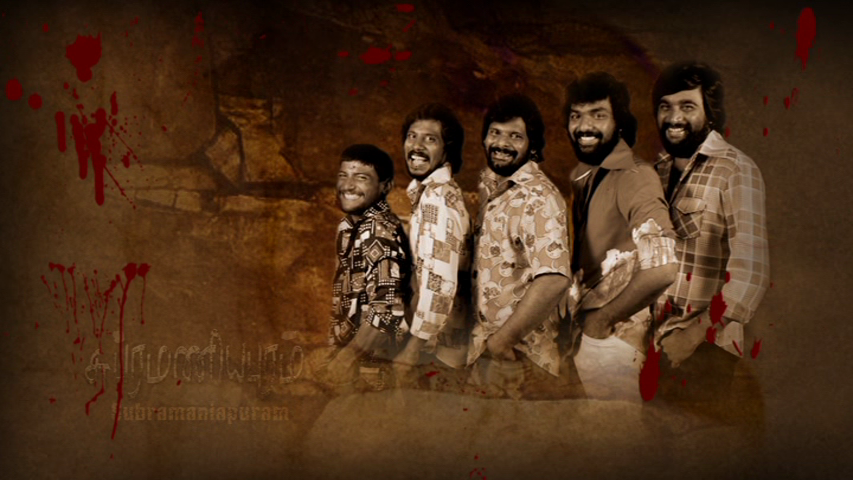
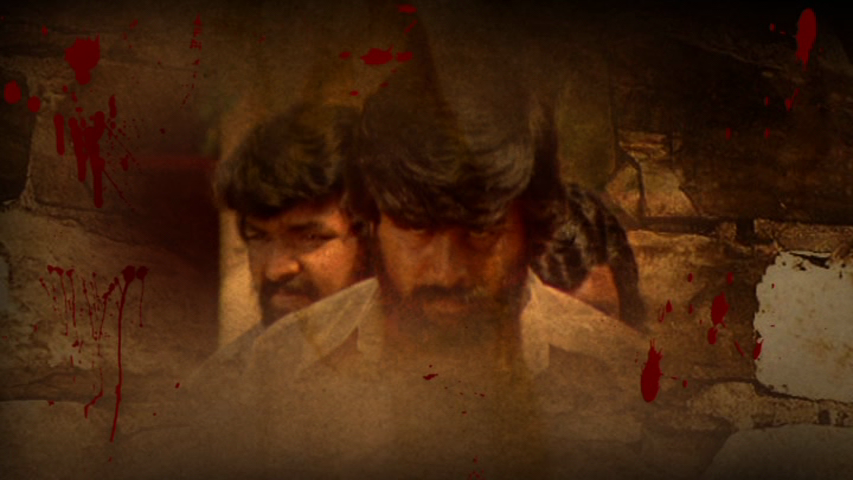
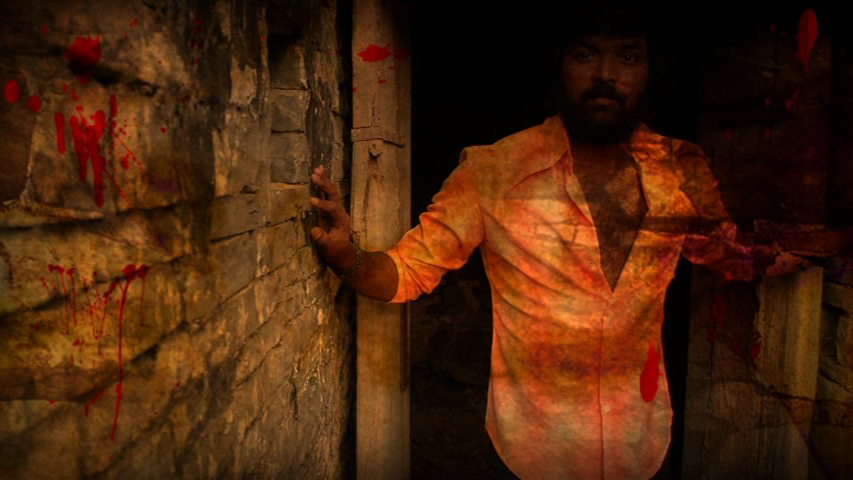
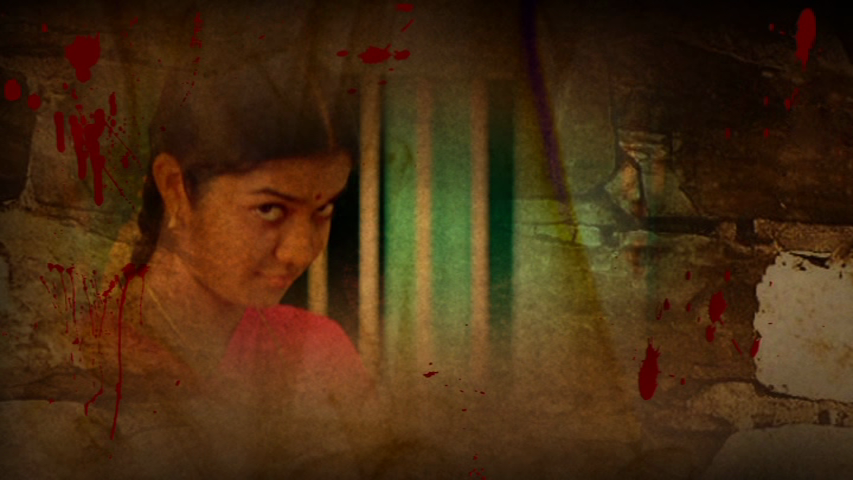
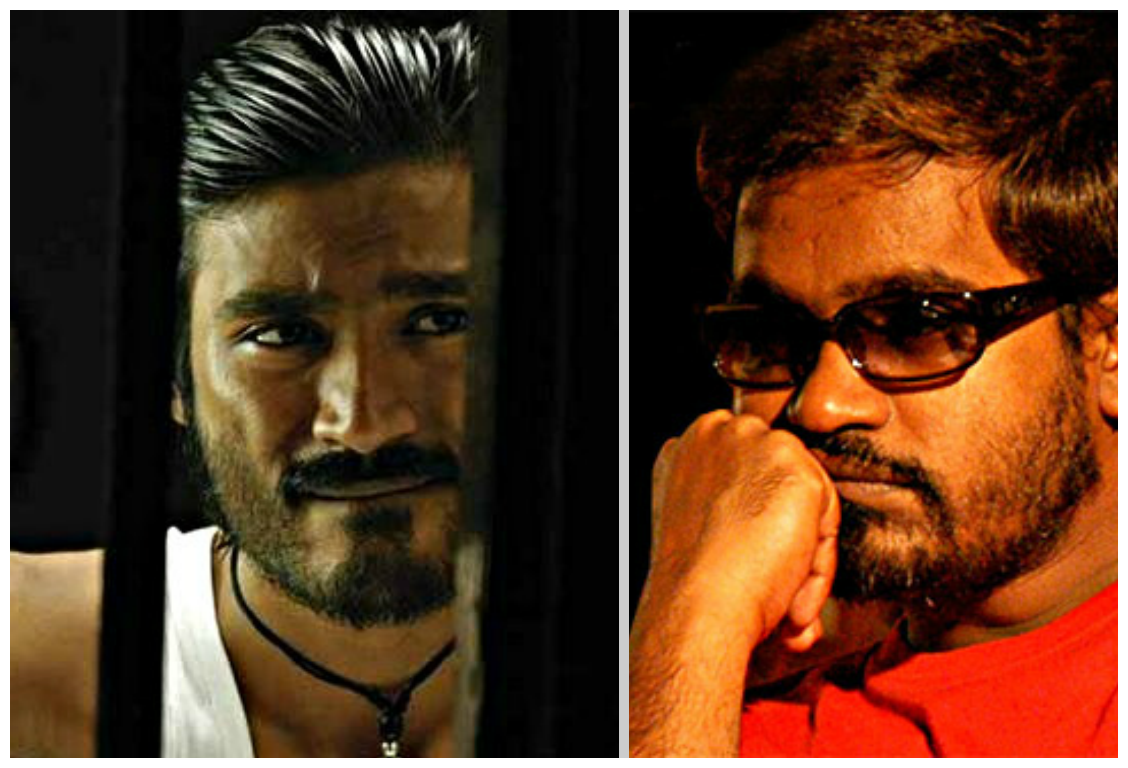


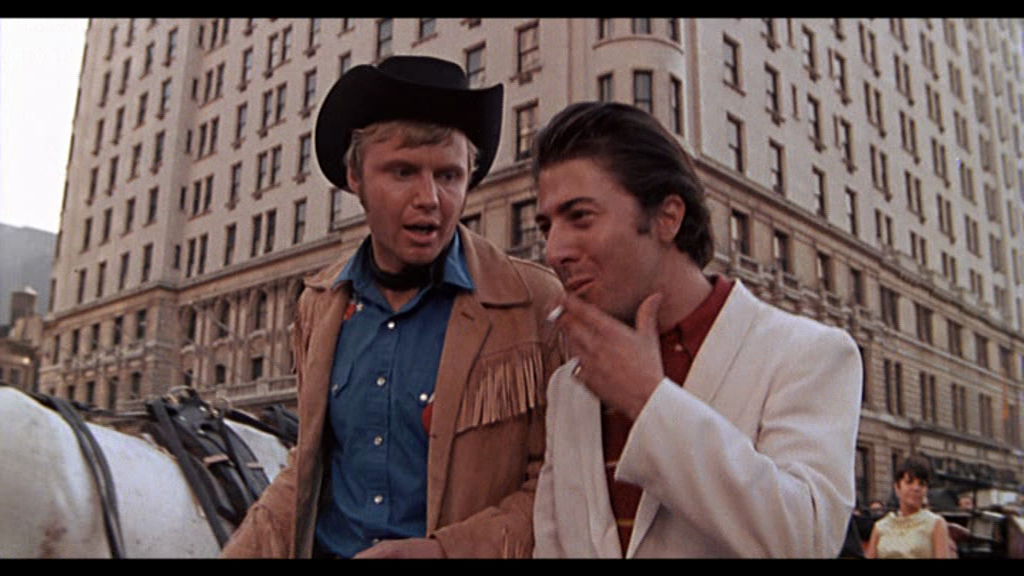




0 COMMENTS
WRITE COMMENT